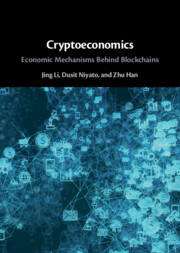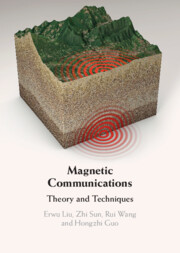Refine search
Actions for selected content:
6829 results in Communications and signal processing
9 - Infrastructure Systems Planning for Improved Resilience
-
- Book:
- Resilience Engineering for Power and Communications Systems
- Published online:
- 04 January 2024
- Print publication:
- 18 January 2024, pp 452-485
-
- Chapter
- Export citation
Copyright page
-
- Book:
- Resilience Engineering for Power and Communications Systems
- Published online:
- 04 January 2024
- Print publication:
- 18 January 2024, pp iv-iv
-
- Chapter
- Export citation
6 - Electric Power Grid Resilience
-
- Book:
- Resilience Engineering for Power and Communications Systems
- Published online:
- 04 January 2024
- Print publication:
- 18 January 2024, pp 276-380
-
- Chapter
- Export citation
4 - Metamaterial-Enhanced Magnetic Communications
- from Part I - Introduction and Properties of MI
-
- Book:
- Magnetic Communications
- Published online:
- 04 January 2024
- Print publication:
- 18 January 2024, pp 63-84
-
- Chapter
- Export citation

Cryptoeconomics
- Economic Mechanisms Behind Blockchains
-
- Published online:
- 06 January 2024
- Print publication:
- 16 November 2023

Resilience Engineering for Power and Communications Systems
- Networked Infrastructure in Extreme Events
-
- Published online:
- 04 January 2024
- Print publication:
- 18 January 2024

Magnetic Communications
- Theory and Techniques
-
- Published online:
- 04 January 2024
- Print publication:
- 18 January 2024
9 - Equilibrium Problem with Equilibrium Constraints
- from Part III - Mechanism Design in Blockchain Networks and Beyond
-
- Book:
- Cryptoeconomics
- Published online:
- 06 January 2024
- Print publication:
- 16 November 2023, pp 210-242
-
- Chapter
- Export citation
Part I - Cryptoeconomics Basics
-
- Book:
- Cryptoeconomics
- Published online:
- 06 January 2024
- Print publication:
- 16 November 2023, pp 21-22
-
- Chapter
- Export citation
Index
-
- Book:
- Cryptoeconomics
- Published online:
- 06 January 2024
- Print publication:
- 16 November 2023, pp 280-280
-
- Chapter
- Export citation
Frontmatter
-
- Book:
- Cryptoeconomics
- Published online:
- 06 January 2024
- Print publication:
- 16 November 2023, pp i-iv
-
- Chapter
- Export citation
2 - Cryptography Basics
- from Part I - Cryptoeconomics Basics
-
- Book:
- Cryptoeconomics
- Published online:
- 06 January 2024
- Print publication:
- 16 November 2023, pp 23-38
-
- Chapter
- Export citation
4 - Consensus Mechanism Basics
- from Part II - Consensus Protocol Design in Blockchain Networks
-
- Book:
- Cryptoeconomics
- Published online:
- 06 January 2024
- Print publication:
- 16 November 2023, pp 53-66
-
- Chapter
- Export citation
5 - Incentivized Consensus Mechanism
- from Part II - Consensus Protocol Design in Blockchain Networks
-
- Book:
- Cryptoeconomics
- Published online:
- 06 January 2024
- Print publication:
- 16 November 2023, pp 67-94
-
- Chapter
- Export citation
6 - Mechanism Design Basics
- from Part III - Mechanism Design in Blockchain Networks and Beyond
-
- Book:
- Cryptoeconomics
- Published online:
- 06 January 2024
- Print publication:
- 16 November 2023, pp 97-133
-
- Chapter
- Export citation
10 - Open Questions about Mechanism Design in Cryptoeconomics
- from Part IV - Open Questions of Cryptoeconomics
-
- Book:
- Cryptoeconomics
- Published online:
- 06 January 2024
- Print publication:
- 16 November 2023, pp 245-254
-
- Chapter
- Export citation
References
-
- Book:
- Cryptoeconomics
- Published online:
- 06 January 2024
- Print publication:
- 16 November 2023, pp 255-279
-
- Chapter
- Export citation
Part IV - Open Questions of Cryptoeconomics
-
- Book:
- Cryptoeconomics
- Published online:
- 06 January 2024
- Print publication:
- 16 November 2023, pp 243-244
-
- Chapter
- Export citation
8 - Contract Theory
- from Part III - Mechanism Design in Blockchain Networks and Beyond
-
- Book:
- Cryptoeconomics
- Published online:
- 06 January 2024
- Print publication:
- 16 November 2023, pp 171-209
-
- Chapter
- Export citation
7 - Auction Theory
- from Part III - Mechanism Design in Blockchain Networks and Beyond
-
- Book:
- Cryptoeconomics
- Published online:
- 06 January 2024
- Print publication:
- 16 November 2023, pp 134-170
-
- Chapter
- Export citation
